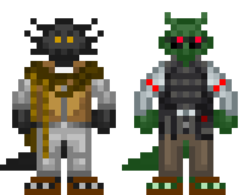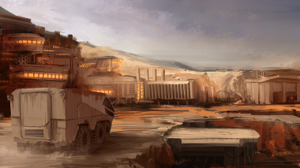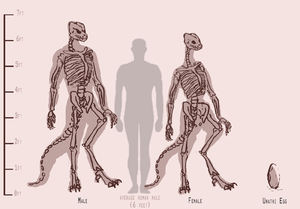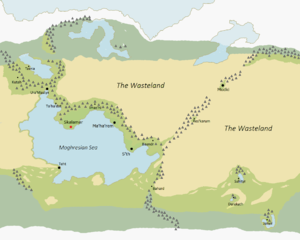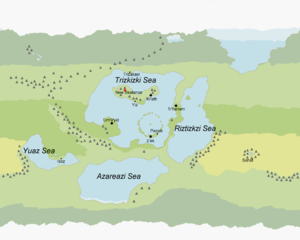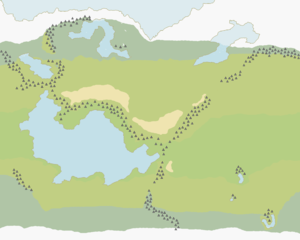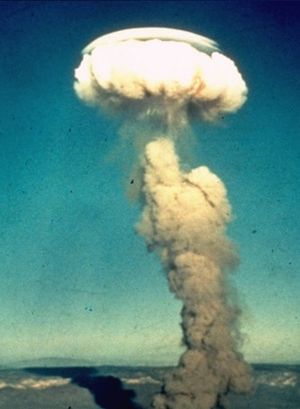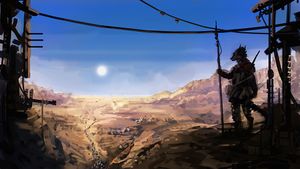Unathi
| Unathi |
| U. Sapiens |
| Home System: Uueoa-Esa |
| Homeworld: Moghes |
| Language(s): Sinta Unathi |
| Political Entitie(s): Izweski Nation / Izweski Hegemony |
Overview
The Unathi are a race of tall humanoid reptiles standing from six to seven feet tall on average, with females slightly smaller in stature. They possess a mixture of snake-like and crocodile-like features, resulting in hard and plate-like scales, excluding the ones on the belly, armpits and groin. Unathi live in their home system of Uueoa-Esa with their homeworld being Moghes. The planet's history can be summarized as being divided up between various hegemonies; names they give the most powerful Clans on Moghes throughout time. The Clan system is deeply entrenched in Unathi society, with everything else revolving around it. It forms a major part of their code of honour, which stresses the importance of martial abilities and loyalty to the Clan.
The Unathi code of honor also has them frown on ranged weapons, with many Unathi preferring melee combat.
After the Contact War, many Unathi which fled the planet through Nanotrasen-built shuttle ports slipped through the cracks and became slavers and raiders, gaining fearsome reputations.
Many Unathi in Nanotrasen find themselves working in security and engineering roles, but recently many have been proving themselves as competent surgeons and brilliant scientists, earning opportunities unheard of on Moghes.
Mechanics
Unathi have slightly improved heat resistance, but increased sensitivity to cold. Unathi have improved unarmed melee attacks, which slash and have the possibility of knocking someone down. Unathi can devour monkeys by clicking and dragging from the mob to themselves. The monkey must hold still for it to work. Unathi hiss when speaking Tau Ceti Basic. You achieve this by typing multiple s's during speech. This can also be pronounced through x's if their accent is thick. "Thiss iss an exssample."
Biology
Their average life expectancy is around sixty years for most Unathi. However, they tend to live for seventy or eighty years when given advanced medical care available to the other space-faring species. As a cold-blooded species, they suffer fatigue and even short comas when exposed to extremely low temperatures.
Since they are carnivorous species, their diet mostly consists of meat, though they do have a tolerance to some plants and fruits. However, they do not get any nutrition from plants, so they are mostly used as garnish or decoration.
The reproductive system of a Unathi is very similar to that of Earth reptiles. Females lay eggs, with the average clutch being somewhere between one and three. They have an six month gestation period, after which they are laid in a humid, warm area. After two months, the fetus is fully developed and hatches from the egg. Unathi are born with their claws and ability to walk within hours of hatching.
Biologically the Unathi of Moghes and Ouere are identical.
Physical Appearance
The Unathi as a species are born into one of four major scale color categories Red, Black, Orange-brown ("sand colored") and Green. Alternative colours are rare, with dark blue and even albino Unathi being reported in very small numbers. Traditionally these off-colored Unathi are met with prejudice, though some clans outside the Izweski may feel different.
The females differ from the males in that they generally have a shorter and more rounded snout. Both sexes stand on plantigrade legs, jointed backwards, and have clawed feet and hands. They also have very long tongues, which may stretch up to a foot and a half long, forked just like a serpent's. In much the same manner as snakes, the Unathi can sample the air around them using their tongue. This tongue is usually black or an extremely dark red, and usually a foot in length.
Social
Social Mannerisms
When speaking to superiors, it is considered formal and respectful to refer to them by the extended name of their command. A clan leader would be referred to by the name of their clan, a squad leader by the name of their squad. Intimate gestures between Unathi include twining necks, twining tails, and touching foreheads/muzzles. Hugging is usually considered something done by children, avoided by adults.
Baring the throat is the single most meaningful expression of trust in a lover or superior, often used as shows of extreme trust, compassion or admittance of shame, and within honorable contexts, clawing or biting the exposed throat is perfectly allowed.
Relationships for Unathi are, suffice to say, not one of equality, but responsibility. Males who request and admit attraction to a female will go to the male who is responsible for their well-being and tell them this, usually boasting or offering tributes to the female's caretaker as well. Trying to ignore the ritual of arranged marriage is a great insult to the female's clan, and at worst could lead to a blood feud and/or war. Divorces are also only possible by the male, with the female given no legal rights or ability to inherit property. However abusing or divorcing your wife is insulting to the female's family and clan and can lead to dangerous feuds.
Emotional Displays
Unathi feel emotions just like humans feel, but with different cues. Irritation or heightened emotion is expressed by thumping the tail against the ground. Verbal exclamations are also common, as are short barks, rattling of the throat, or 'chuffing' (forceful exhalations of air from low in the throat). Anxious or worried Unathi might sway (similar to snakes), rattle the heavy scaling on their neck, hiss, or sample air more often than necessary. When cold, Unathi will usually bristle their scales in a manner analogous to human goosebumps. When overly warm, Unathi usually become sluggish and drowsy.
Culture
Moghean
Moghean Unathi are traditional Unathi, with the planet being their homewold. Historically culture varies across Clans which exist on the planet, but some customs and norms arch over nearly all Unathi universally.
It is a social faux-pas to use a Unathi's first name if not family or extremely close to the Unathi in question. Generally a Unathi will tell someone when they feel comfortable with the person using their first name. It is also distressing to Unathi to touch their tail, or to touch them at all before introductions are undertaken.
Unathi place great emphasis on oral traditions. Most festivals and ceremonies, and even formal Unathi education focuses on oral history and practices. The unathi system of writing developed around 983 CE, originally intended to keep track of soldiers and weapons, giving it a very simple alphabet. The modern day unathi alphabet has 34 letters. Writing and reading are seen as men's work, with most Unathi women discouraged or even banned from learning.
Outside the formal schools of the Untouched Lands, village and town shamans often remain the only source of education for many young unathi.
Ouerean
While the Unathi of Ouere follow most of the same social beliefs as their Moghean counterparts, they tend to be less volatile towards outsiders who are ignorant of their customs, especially since their world was formerly ruled by the Skrell and Humanity. The culture of humanity and Skrell have managed to influence Ouerean Unathi, embedding different cultural norms. There is a focus on an Unathi’s ability to benefit the group, with most Unathi being given the same chance as anyone else. There is still a struggle with a highly stratified society, but things are much more liberal than on Moghes.
Many of the original colonists started as patriots to the Izweski Hegemony, but many soon found themselves disillusioned with the distant home world tearing itself apart in war. Many of them became enamored with human and Skrell culture and ideals of democracy, equality, and liberalism; finding themselves resentful of their old lives on Moghes. Reintegration into the Hegemony has proved difficult as both planets try to reconcile these cultural differences.
Ourean art, in contrast to Moghean pottery and dyed fabrics, has taken on inspiration from human and Skrell art. Many Ourean Unathi have become renowned glass makers and craftsmen. The greater access to human and skrell universities - many of which still operate on the planet - also give Ourean Unathi greater chances to specialize with human and Skrell systems.
Women
Women are very much a subjugated underclass in traditional Unathi society. The legal differences between Unathi women and "property" is vague. They are discouraged from reading or writing, can't join the military, and are expected to cook and clean the household while looking over the children of the clan. They legally cannot divorce from their husbands, and their marriages are often arranged by the male elders of their clan. They're political tools used to create alliances between Clans.
Women still do hold power in some ways. When married, their former clan can lose a lot of face or honor if she's mistreated or divorced. Entire wars have broken out over divorces or accusations that the husband is mistreating the female. Unathi women are also in charge of the education of Unathi children until they're 5 years old, when they go to formal schools. Outside the Izweski Hegemony on Moghes, women are often tasked with the education of their children until adulthood, aided only by the local shaman's teachings.
Religion
There are two major religions of the Unathi.
Th'akh
The most pervasive and common religion amongst Unathi. It dates back even before the First Hegemony, and as a byproduct of Unathi stubbornness has remained central to Unathi spiritualism. The basic concept of Th'akh is that all the spirits of past Unathi now reside in the spirit world that exists in tandem with the material world. These spirits exist in objects and nature - bringing either good luck, or sorrow. Particularly nasty natural disasters were often attributed to particularly strong groups of spiteful spirits influencing events in the material world. They tend to paint their bodies in paint blended of berries, some shamans even going so far as to mark themselves with the name of villagers who died in his village, making him or her a walking library to add onto the strong oral traditions of Tha'kh. This practice, for obvious reasons, tends to be more common in smaller villages.
Many tribes had their village shamans, who were elderly males - or rarely, women - seen as having a special connection to the spirit world. They consumed mind-altering herbs to enter and interact with the world of spirits, and to channel their energies into the spiritual world. Tribes would hold elaborate rituals where the village shaman would call upon the ancestors of the hunters or warriors to enter their weapons or fill the warriors with great courage and ability in battle. In modern times, this ritual is still practiced, but most unathi now call their ancestors to fill their weapon and grant it extraordinary abilities before they enter battle.
Shamans tended to live simple lives, and dedicate their efforts to improve the community. They were spiritual leaders, and it was very rare that any got involved in politics. This lead to them being exploited by the Izweski nation, who drafted many into the army to make them perform rituals for the soldiers, often under duress. After the war ended with the nuclear devastation, the shamans began to be discriminated against by the government, and many are leaving the Izweski nation as travelling shamans or even leaving Moghes entirely. Very rarely do shamans enter Guwandi, but it is not unheard of.
Sk'akh
The second most common religion, which is followed more by Unathi from the Izweski nation. It still follows the ancestor worship of Th'akh, but with a major notable difference. The spirits of all unathi who die become part of Sk'akh, the Great Spirit. Sk'akh is a gender neutral God, being called 'he' or 'she' interchangeably to represent that Ska'kh is a collection of all unathi. She is often called Three of One, because the spirits combine into three minor Gods that are all part of Ska'kh: the Warrior, the Healer, the Fisherman. These three spirits are personifications of the most important aspects of Unathi society. It is said that all three are equally important, and that disasters are caused by an imbalance in the Great Three.
Sk'akh priests tend to try to embody one of the Great Three. They become warrior priests, doctors or surgeons, or aquatic farmers. Warrior Priests of Sk'akh are near universally highly respected, and form a small, elite fighting force that is on par with the War Riders. They go into battle with intricate runes drawn across their armoured plates, chanting to Sk'akh for her blessing in the battle. Regular worship is communal, with Unathi clans or villages coming together for feasts or festivals to give thanks to their ancestors and Sk'akh for good tidings, or to ask for favours or assistance in life, with a priest to guide the service or provide interpretation of Sk'akhs intentions or assistance in contacting ancestors.
Politics
Moghes is divided between the Izweski Nation, which exists in the Untouched Lands, and the hundreds of other Clans and nations who claim their own land across the planet's surface. The only real difference in their political systems is the scale. Many of these other clans are modern nations or pre-industrial, ruled by various kings or leaders. However with the expansion of the uninhabitable Wasteland and the brutal decimation Izweski forces committed on foreign leadership many institutions of Non-Hegemony government across Moghes are rare or extremely fragile.
Izweski Nation
Izweski is lead by Clan Leader S’kresti Izweski, a 56 year old Unathi who ruled the country since he was 38 after his father Kitaskis Izweski, the previous Hegemon, died from liver failure at 61. He lives in the Izweski Citadel in Skalamar, and under him are the Lords who rule their own subjugated clans. They live in a feudal system, with the Lords usually being clan leaders or important clan members themselves who pledge themselves to Izweski in exchange for land and protection.
The Hegemon is the Emperor, and under him are the Overlords, who are the Kings. Under the Overlords are the Lords, who are then broken up between the Clan Lords, and then the Clan Leaders.
Overlords rule an entire planet in the name of the Hegemon. Currently there is only one Overlord, who rules Ourea.
There are two different kind of major lifestyles In Izweski. There is the city, which is ran by a Lord and a small council of lesser clans. City life is less harsh than life in the country, especially with opportunities provided with shuttle services to the rest of the galaxy.
Life in the country is harsher, with cities being rare and life mostly determined by the size of a Clan's village and how well they can hunt, and raid their neighbors. It's the traditional Unathi life, made harsher by the growing Wasteland encroaching on once fertile lands.
Ouerean
The Ouerean Government used to made up of a Colonial Government with a human Governor and Skrellian advisors and mayors. Since the Hegemony regained control of the planet, it is overseen by an Overlord, who is currently Tarkart Yiztek. The native Ourean unathi elders have created an administrative council to help rule under the Overlord, and there is an attempt to blend the law codes of the former Colonial rulers and ancient code of honour of the Moghean Unathi.
The planet is struggling economically as it deals with reintegration into the Hegemony as well as a growing refugee crisis. The Izweski on Moghes have been attempting to ship as many refugees from the Wasteland to Ourea as possible, causing the population to skyrocket. Many Ourean cities, modern and comparable to large cities in the 22nd century Earth, are now suffering with an explosive growth of slums.
Many humans still reside on Ourea, and the planet is much more mixed than Moghes. There is also difficulty in integrating the previous republican planet into the Unathi system of vassalage and appointment - many Representatives and mayors lost their positions.
History
Pre-Hegemony
While most records were tragically lost in the later years of the Contact War, Unathi and human scholars theorize that Unathi lifestyles were predominantly nomadic in their early history. Up until 100 CE Unathi clans consisted of small villages usually numbering no more than 500 following the large herd of Threshbeasts across the savannahs that dominated the planet’s surface. Clans at the time weren’t accostomed to using weapons, as their natural talons served well enough to kill enemies in battle, leaving most early unathi warfare being brutal hand-to-hand affairs.
Around 300 CE, many clans had settled down after discovering the benefits of aquaculture, or the mass husbandry of fish, as well new innovations in preserving meat. The population swelled, and the first true cities had established themselves.
The planet was still divided amongst several hundred different clans, all of which were nearly unanimously hostile towards one another. Trade between clans was limited, leaving the balance of wealth and technological advancement severely stratified.
The First Hegemony
What few surviving records remain show that by 1000 CE, most of the planet’s surface was dominated between a dozen clans, each holding vast swaths of land. The Kres'ha'nor Clan is shown to have been the most powerful, controlling a population base of twelve million and a professional army, including the first recorded use of War Riders. They ruled over numerous Lords, all of whom lived in a system of feudalism, owing the Kres’ha’nor clan their loyalty and armies in exchange for protection and land.
The Kres’ha’nor Hegemony lasted from roughly 920 CE - 1500 CE, benefiting from the brutal War Rider shock troops wielding steel glaives and heavy maces. It was the unquestioned power of the world, owning land and wealth which allowed it the industries necessary to forge steel, levy taxes, and even build walls around their cities to protect from raiders. This lasted until Clan Leader Kresshi Kres’ha’nor had died, his many sons fighting over who would rule the Clan in his place. The Hegemony fractured and collapsed into a dozen smaller, feuding clans with the Kres’ha’nor dynasty itself disappearing completely after the war ended.
The Kres’ha’nor Hegemony had subjugated its neighbors for many years, and with it collapse the rest of Moghes began to gravitate away from one another and back to their isolated way of living.
Growth of Guilds
The 1600's saw a new phenomenon develop, originating within the divided kingdoms of the former Kres'ha'nor Hegemony. When merchants found they could accomplish more as a group rather than through individual effort, they banded together to form guilds. Guilds formed for bakers, butchers, grocers, millers, smiths, carpenters, weavers, mason, shoemakers, in fact, nearly every trade had its own guild. Standards such as just weights and measures evolved from the guilds, and guild inspectors would inspect shops to ensure rules were being followed. Guilds would help members that were sick, or in trouble, and would sometimes take care of families after the member died.
Apprenticeship was how most started in a particular trade, which they would follow the rest of their lives. After completing an apprenticeship, the appropriate guild would examine his work and see if he could be elevated to a Craftsman. A Craftsman was required to create a "masterpiece" in the presence of judges to be elevated to Master status, which would allow him to join the leadership of his guild.
Guilds also built and ran the first universities on Moghes, the first known being the University of Ma'ha'rem which opened in 1602. Originally trade schools, they slowly expanded to become centers of learning for apprentices of every field. A doctor would have to first become a "Master" through a university to be allowed to practice his trade within towns or cities controlled by a guild of doctors, and the same for any other brand of skilled work. A Master's certificate also distinguished someone as a professional with few peers, giving their holders immense prestige and trust. A fully credited and certified doctor on Moghes would be (and are still) known as a Master Doctor. Typically they are known as [Rank] [Craft], so you can also be a Master Weaponsmith or Master Engineer.
Eventually these guilds managed to form powerful monopolies and they spread their trade and influence across Moghes. Most of the landed elite feared the growth of the guilds, who were creating a new middle-class of urban worker. That a peasant could rise to gain prestige and vast wealth with no land, titles, or martial victories under their belt was an idea bewildering and frustrating. The late 1600's and the beginning of the 1700's saw many Kingdoms across Moghes cracking down on the power of guilds, stripping them of privileges or banning craftsmen from meeting in groups. Other nations ruthlessly suppressed private enterprise. Many laws were passed that strictly limited how many members a guild could possess, as well as requiring all craftsmen to register with their local Lords before being allowed to sell any goods or services.
The Second Hegemony
In 1823 CE, records show the first use of a steam engine by the Ras’iks Clan in S’th. The technological breakthrough sparked industrialization amongst the urbanized clans, but the developments weren’t felt beyond the new industrialized nations. It was even rejected with outright hostility in many areas outside the city, with many unathi resenting the upsets to traditional ways of life. Surviving records have numerous accounts of uprisings and attempts revolutions in industrialized nations, while the more primitive neighbors continued to aggressively raid their more advanced, and thus wealthy neighbors. It’s unclear if these events were random violence, or the first global war amongst the Unathi clans.
The growth of industrialization also threatened the major Guilds. In the centuries before industrialization these organizations were associations of artisans or merchants who control the practice of their craft in a particular town or city. The introduction of factories and growth of unskilled labor disrupted the entire concept of skilled labor; many skilled craftsmen found themselves outpaced and outproduced by a single factory. The consequences of industrialization also saw an explosion of urbanization, with large populations of unskilled workers migrating from rural areas to get jobs in the cities. Unathi society transformed itself from a primarily aquaculture (the mass farming of fish) society into one based on the manufacturing of goods and services.
It's shown with limited surviving records that, by 1922, the Sarakus Clan rose to power following a war amongst the industrialized nations and created a Hegemony. They ruled most of the land around the Moghresian Sea and the vast planes to the east of the sea. Their clan ruled harshly, and forced technological advances into the cities and towns in order to increase the wealth of their clan and loyal Lords. The Sarakus abolished the private Guilds and consolidated their associations and enterprises to be controlled directly by the throne. The Sarakus leased out titles to factories, businesses, and other enterprises to landed Lords of the realm. This allowed the ruling elite to continue to directly control the lower class of unskilled labor just as they did before industrialization.
Industrialization
In 1931 the Sarakus also embarked on several ambitious projects to modernize the empire, all under the ambitious plan called the "Great Endeavor", the brainchild of Hegemon Azyi Sarakus. While electricity had been known and produced on Moghes since the 1800's electricity was still rare and limited to the capital and a handful of other major cities. Using vast amounts of unskilled labor the Sarakus built hundreds of coal and hydroelectric power plants, all leased out to be operated by loyal nobles. Cities all found themselves with access to electricity within 10 years. Light-bulbs replaced candlelight, and street lights lit up the roads and sidewalks even on the darkest of nights.
Ambitious infrastructure projects were also embarked on. The concept of gasoline-powered cars had been known, but the vast majority of roads across the Sarakus Hegemony were dirt roads unfriendly to mechanized travel. Travel was exclusively done by walking or, if you had the money, riding on Threshbeasts. A vast stretch of cobblestone roads was built between every major city and within them. While the streets within cities were being torn up, the Sarakus also had the ancient, decrepit sewage systems modernized and improved in a massive sanitation project.
Radio coverage was expanded across the globe as the Sarakus expanded radio coverage and built telephone lines, allowing every corner of the Empire to have direct and quick communication with the capital.
The Great Endeavor took 20 years, and Azyi Sarakus died of old age at 62 before being able to see it finished. The project was symbolically finished with a grand opening of the Sarakus Castle after it had gone under renovations to modernize it with electricity and modern plumbing.
In the end the Great Endeavor ruthlessly modernized Moghes. While the benefits to the state were immense, there was also significant uprooting of traditional Unathi society. With the modernization of factories and growing industrialization skilled labor was becoming less valued. While the wealth of the Sarakus Hegemony increased, many within and outside the empire began to resent the growth, feeling that the Sarakus had urbanized and industrialized the empire at the expense of its soul.
The rest of Moghes was divided as it always had been, between non-industrialized unathi nations. Technology and innovations from the Sarakus slowly trickled into their Clans and kingdoms, but life existed much as it had for a thousand years. Most Clans still fought with steel weapons and armor while the lower classes acted as manual labor in aquaculture farms or mines beneath the wealthy elites of skilled craftsmen.
The Third Hegemony
We do know without a doubt that in 1994, the Sarakus Clan ceased to exist after a sudden coup by a group known as the Traitor Lords. They stormed the Sarakus castle in Ma’ha’rem and slew the entire family and contingent of Clan Guard, establishing Lord Neeziah Izweski as the new ruling Clan Leader. The sudden, brutal coup sent shock-waves through the nation. It was almost unthinkable that Lords would turn on their Clan Leader in such a way.
Immediately most Lords rebelled, forming the Honored Alliance. The civil war lasted for decades, spreading to include most of the planet and Clans. It was a new type of war, with ballistic weapons first used by Izweski infantry. The bullets are most similar to 21st century Earth anti-tank rifles, but due to Unathi armored plates became a standard infantry weapon. Heavy, unwieldy, and expensive to make with the limited industry, no more than a few thousand were ever fielded. But when they were used, it’s recorded that they were devastating. Wielding melee weapons and charging into battle as they always had, War Riders and infantry would be whittled down from unheard of distances.
The war lasted until 2079 CE, when the Honored Alliance signed a cease-fire with the Izweski Nation. The war had seen many cities razed and looted, and deaths in the millions. The entire planet of Moghes was wounded, and would not recover for decades. Until First Contact, the surviving Clans and Izweski Nation rebuilt and consolidated their power.
Once their control of the empire was secure, the Izweski embarked on several ambitious projects that completely reversed the policies of the Sarakus. The Izweski abolished the control of the nobility over the Guilds while encouraging the concept of free trade. Regulations over the Guilds vanished within a few short years, and the 2100's saw a rebirth of these associations. They eventually evolved into trade unions in the 2120's. Industry and business was privatized as the nobility lost their privileges over the economy and workers. Many of the established elite resented these changes. Anti-union violence exploded in the 2120's and 2130's, with Lords and Clan Lords using their troops to brutally suppress union strikes or meetings. Many lords also revolted against the Izweski in the same period,demanding their privileges be returned. The uprisings were met with brutality, with victorious Izweski commanders often decapitating rebel leaders.
The Modern Economy
Despite the unrest and turmoil industrialization and free trade had brought to the Izweski Hegemony the process continued. By the turn of the century in the 2200's an early form of globalization and mass media had developed within Moghes. The growing middle class within the Izweski Hegemony had grown to be a sizable economic and political force, but interestingly the innovations and reforms drastically changed the cultural and social spheres of Unathi life there is very little evidence of radical political change.
Major cities across Moghes were filled with clunky cars navigating traffic as stoplights replaced traffic cops, and most homes had access to televisions, radios, and other modern amenities. Guilds owned monopolies over specific goods and services. Powerful merchant families owned hospital chains, pharmaceutical companies, car companies, television networks; a dynastic control of private enterprise had developed. An urban, middle-class Unathi found themselves with all the modern luxuries and basic goods that were available to the average human in the 21st century.
However there was also a significant population of the lower and under-class in urban Unathi society. Nearly every major city had sprawling slums that surrounded the industrial districts, filled with underpaid factory workers who ironically found their rights curtailed by the powerful trade unions. Guwans specifically were ruthlessly exploited, forced to work as street sweepers or maintain the sewers. Orphans found themselves cared for in boardhouses owned by a Guild until they turned 16, when they were forced to work for the Guild to pay back the debt they incurred caring for them.
The Izweski are recorded to have made little effort to alleviate the abject poverty many Unathi were suffering from the rampant abuse of the major trade unions, believing that the consequences were necessary to maintain a modern, functioning empire.
First Contact
In 2433, a human exploration team discovered Moghes. Shortly after, first contact was made. Humanity established contact with Clan Izweski, which proved to be controversial amongst the Sol Alliance. Many people questioned the morals of interacting with a pre-warp race that had only reached the technological level of Earth in the 21st century. But unheeding the warnings, Sol Alliance merchants and scholars flocked to Moghes, living under very careful observation and guard in Izweski cities. Skalamar, the second largest city in Izweski, became the first Unathi city to have a shuttleport constructed. Owned by Nanotrasen, it served to transport people to and from the planet’s surface.
It should be noted that before First Contact, Moghes had the technological level equivalent to Earth in the early 21st century. However this was extremely stratified and mostly constrained to the major cities in what is now known as the Untouched Lands. Other areas of Moghes, namely in the countryside and outside Izweski control, were equivalent to Earth in the 20th or 19th century. The Unathi had access to modern medicine, universities, and other modern amenities, if they were a member of the middle class or nobility. However most of the wealth was concentrated in the hands of landed vassals, and few unlanded Unathi had the ability or means to advance in society. A complex global trade network was also present. Unathi at this time had mechanized, with access to clunky, open-top cars powered by traditional gasoline. Power generation was utilized mostly through natural gas and hydro-electric dams along with other biofuels. All major cities had modern infrastructure and civil services, electricity, and plumbing.
The Contact War
In 2437, the Izweski Nation had established the Izweski Space Program, and with bootlegged Sol Alliance technology constructed a rocket intended to carry 300 unathi colonists to their system’s second habitable planet, Ouerea. The launch was a disaster, with a yet-unidentified failure causing the rocket to explode after reaching 2,000 feet and the death of all hands. The failure sends shockwaves through all of Moghes, with the Izweski Nation suddenly besieged by scattered, angry neighboring Clans outraged by the unnatural use of technology leading to the loss of so many lives.
The Sol Alliance partnered with the Jargon Federation to help Izweski construct a second rocket, with Nanotrasen engineers and scientists helping construct it. Its launch was successful, and Ouerea was colonized by 350 Unathi under the guidance of the Sol and Skrellian Alliances on February 3rd, 2438.
The other Clans of Moghes were horrified on this turn of events, seeing the entire Unathi way of life being turned upside down so quickly. They blamed the Izweski Nation of coddling “alien invaders”, and formed the Traditionalist Coalition, which invaded the Izweski Nation. Izweski itself began to see civil unrest from angry commoners and Lords.
It sparked a war which is now known as the Contact War, which began with the sudden invasion of Izweski lands east of Res'karum three days after the Colonists landed on Ourea.
Humans and Skrell evacuated the planet as the fighting got underway. The Coalition fought as its clans always had, with steel weapons and hand-to-hand combat. The biggest concession was the use of ballistic weapons, and propeller aircraft which they used to bomb Izweski targets.
The Izweski used Skrellian and Human energy weapons like energy glaives, swords, and laser carbines, as well as fielding several hundred Mk I “Breacher Suits”, which the Izweski nation invented and utilized to frightening efficiency. They proved effective, but with the lack of Izweski air power both sides could do little more than gain temporary victories.
The war was portrayed in Izweski propaganda as a war against backward savages. Unathi from the Traditionalist Coalition were 'dehumanized' and people were told to consider them as barely sinta'Unathi. Many Izweski Unathi feared that the Traditionalists wanted to destroy modern society itself.
The Izweski were portrayed by the Traditionalists' propaganda as alien collaborators. The Izweski were painted to be oppressive puppets to the humans and Skrell, forcing literal alien culture on Moghes without the consent of its population. Many sincerely believed that the Hegemony was threatening the very foundation of what it meant to be Unathi, shaming their ancestors or having lost the favor of the Great Spirit.
The Jargon Federation found itself shocked by the violence unfolding on Moghes. They dispatched a cruiser to orbit over the planet, and transported down a peace delegation to the Coalition capital city. The shuttle was shot down by Coalition anti-air weapons, killing everyone on board. Offended, the Skrell moved their cruiser in the system in orbit around the Ouerean planet, pledging to never again provide assistance to Moghes, while Nanotrasen continued to do just that.
The war dragged on for the rest of the year, with battle lines changing rapidly. As the fighting intensified, many clans found their entire levy called out to battle, leaving their own clan territory lightly garrisoned. Coalition ground troops were butchered en-masse by the Izweski Breacher Suits, which could absorb laser and bullet fire similar to Terran tanks. But the Coalition had used heavy artillery to shell Izweski forces, to which the Izweski were slow to respond to. Many Unathi on both sides faced serious and upsetting decisons in which they had to weigh the safety of their soldiers and vassals along with the success of their operation against ancient Unathi customs of honorable warfare that had held more or less firm for thousands of years.
On September 5th, 2439, the Traditionalist Coalition suddenly dropped an atomic bomb on the Izweski city of Da’ha’den, obliterating it. It’s unknown how the Traditionalists gained access to atomic weapons, but the consequences were catastrophic: both sides began a continued exchange of atomic weapons that lasted for a week. Hundreds of nuclear weapons were detonated across Moghes, and orbiting, observing Alliance stations and vessels having their shutters lowered to prevent eye damage to people observing during the time of the exchange. Hundreds of millions of Unathi were killed within the first few days by direct atomic detonations alone, with hundreds of millions of more Unathi dying as the weeks dragged on and the fallout spread across the planet.
In the end, atomic hellfire had seen most of the planet's surface vaporized or blasted with radiation. Despite this, violence continued to spill across the planet as the initial war of ideology turned into a desperate fight to secure the remaining, non-affected areas. The continued conflict continued for 10 more years, with every level of Unathi society affected in one way or another. No clan escaped unscathed, and many lost their entire levy or even their entire dynasty when the atomic weapons were dropped. The Contact War did not end until exhausted Izweski forces captured the Coalition capital city of Darakath on 2449, which had been their relocated capital after the original, Tisxaclas, was destroyed by several atomic weapons.
In retaliation for the war crimes preformed by the Traditionalists, being the atomic detonations and multiple other accusations, every single Traditionalist leader was decapitated over the next few months. At the start of the war the population of Moghes was 8 billion, and by 2458 it stands at 6.2 billion.
Unathi Today
By 2457, most of the interior of Moghes is uninhabitable. While the yields were lower than thermonuclear weapons, the fallout is still posing massive problems for Moghes. Most of the planet is now engulfed by a single desert, which is aptly named “The Wasteland”. During the Contact war and after it, the Izweski Hegemony has found itself facing a catastrophic collapse of the eco-system. The sole remaining cities still functioning exist in the Untouched Lands; shielded by the massive mountain ranges from the fallout and encroaching desert sands.
The Izweski Nation exists as a shell of its former self. Its influence extends around Skalamar and Ma’ha’rem in the Untouched Lands, with Hegemon and Clan Leader S’kresti ruling it unquestioned, but the rest of the planet has devolved into the feudal system of Clanship, with ideologies, technology, and economies varying wildly. Moghean Unathi find themselves faced with the choice of continuing to do little more than etch out an existence on the home planet, or take lucrative offers from Nanotrasen and other megacorp to join their workforce. In addition, the Hegemony finds itself facing massive swarms of refugees spilling through its borders. Many Lords and Clan Lords have tried to shut the gates to the refugees, as millions of them continue to seek refuge in the Untouched Lands, overwhelming the already stressed support structures of the Izweski state. Since the end of the Contact War the Hegemony has tried to deal with these refugees by shipping them off to space as fast as possible, many of them being former Traditionalist or even Izweski warriors that returned home to find their clans had ceased to exist. This accounts for the large number of Unathi raiders present in knwon space. The population remains at 6.5 billion Unathi, and remains in a steady decline. It is estimated by human scientists that Moghes will be rendered completely uninhabitable to Unathi life within 100 years unless the planet is terraformed to mitigate the damage, though terraforming inhabited planets remains incredibly dangerous.
The Ouerean Unathi are faring far better. Though it was jointly administered by the Sol Alliance and Jargon Federation, it was restored under the direct control of the Hegemon during a series of diplomatic incidents in the summer of 2457. Now it faces an influx of immigrants from Moghes placing stress on its institutions and shaky transition back to the Hegemony, and an upset away from the more liberal lifestyle they enjoyed under the Skrell and Human administration...
Notable Information
‘Guwandi’
In the event that a Unathi becomes mortally ill, or finds themselves lacking the pride or honor to continue to live, or simply become tired of their existence undergo a ritualistic suicide and take the title of 'Guwandi' (which is translated to Gladiator/Galdium). They will give up their possessions to their clan leader and make their journey into the Moghes desert. The only things they keep are their weapons which they use to fight animals or other Unathi so that they may die in honorable combat. In the event that two of these Guwandi meet, they will first draw their weapons and adopt a passive stance, which is followed by them telling each other their stories in turn, as well as the reasons behind their choice of adopting the mantle of 'Guwandi' and how they wish their remains to be dealt with. When both sides understand the other, combat will begin with a mutual wish of luck that the more worthy of death lose with pride. The winner of the battle is responsible for taking care of the corpse in the way they were instructed to. Renouncing the deathseeking life of Guwandi isn't easy. Some may wish to return after having been granted a second outlook, or hope, after they had spent time wandering and risking their life. Their clan may see their decision as cowardly and refuse to accept them, or be overjoyed they had learned a lesson in their time.
The Guwan
In some cases when a Unathi is exiled from their clan, they do not take up the formal title of Guwandi. This can be through fear of death, unwillingness, or simple stubbornness. In this case, they are marked as 'Guwan' by their clan leader, and must take this as their last name. It is a variation on Guwandi, which is translated directly as 'exile'. Guwans are clanless Unathi, and form an underclass. Guwans find it difficult if not impossible to advance socially or politically, and in many cases are oppressed or mistreated by other Unathi who view them as troublemakers or criminals. The only way of returning to a clan after banishment as a Guwan is to be adopted back into the Clan, which happens very rarely.
Many Guwan have been forced off of Moghes by their clans with the growing ease of space travel, and Nanotrasen has a long history of exploiting this subgroup of Unathi, coercing them into employment contracts.
Notably, Guwan are the only social class of Unathi allowed to serve in the personal guard of the Hegemon and his family. The strategy relies on the fact that the guwan of the Guwan Guard are despised and envied by decorated officers that would otherwise serve in traditional guard duties. They are socially isolated and unable to advance politically, which means that their survival depends on the safety of the Hegemon and his family, which means that they wouldn't try to launch a coup or replace the Hegemon without themselves being slaughtered. Similar to an old-Terran Janissary, they're a slave soldier, and unable to have children or hold any sort of political or military position.
Military and Battle Honour
Most battles are fought by infantry, as mounted units are something uncommon in modern times due to the growing use of ranged weapons in combat. When War Riders do show up, they function like human knights, using their mount to run into the enemy formation and swipe at heads or necks. They fight with war glaives and laser pistols, riding their massive, armored Warmount beasts. Threshbeasts are smaller, 'salamander' like creatures also ridden into battle, which are lighter and thinner but are much faster than the cumbersome Warmounts.
The Unathi have also created and field Breacher Suits, which are heavily armored EVA suits that let a single unathi function as a walking armored tank on both terrestrial surfaces and in space.
While modern ranged weapons has been becoming more standard in the Izweski Nation, the vast majority of Unathi shun them and consider them dishonorable. Melee weapons and claws are the most important tools of battle to the vast majority of Unathi. They take extreme pride in their weapons, and there is honor of killing someone in hand to hand combat that many Unathi consider completely absent in human warfare.
This even extends to space warfare. Despite being the youngest spacefaring species, their unpredictable and borderline suicidal tactics often take their opponents by surprise. Unathi combat vessels tend to be heavily armored at the front, with huge plasteel spears mounted on the front. The typical strategy is to turn engines to maximum power and bluespace incredibly close to a target vessel to "ram" it - often getting as close as 500 feet. Many ships can be split entirely in half by the ramming of the heavier Unathi battleships.
With breacher suits modified to be functional in the vacuum of space, marines jettison from the unathi ship and attach themselves to the target vessel, breaching it with plasma cutters and boarding the ship with energy weapons.
The strategy is devastating when used effectively - very few ships can withstand a Unathi boarding action because few Captains or Admirals expect such outlandish tactics to be executed with such zeal. Unfortunately for the Unathi, their tactic relies on the element of surprise or disbelief from their victim. A seasoned captain or admiral can easily counter unathi ramming actions.
With honor, dishonor is an actual criminal crime. It's illegal to mistreat the helpless, infirm, or any prisoners taken by a soldier. The mindset is that there is nothing to prove in abusing someone at your mercy, which just becomes sadism and can stain the honor of the offender's clan. Unfortunately the behavior of Unathi Raiders and slavers in the frontier have given most people the perception that even the military of the Izweski participates in abuse or slaughter, a stereotype that the Hegemon military is growing increasingly sensitive of.
Diet and Cuisine
Unathi dishes are mostly, or all made up of meat, eggs, and fish, as they are a carnivorous species. It may be cooked, or even still raw and bleeding. Vegetables in meals are often just for decoration or flavor, but by no means ever make up the majority of the dish. Unathi do not take any nutritional value from plant matter, only from meat. Desert flowers may also be placed on the plate to make it seem well presented, and are also edible. The tools Unathi use to eat are very unorthodox to humans.
Important meals like dinner and breakfast are meant to be consumed while surrounded by family, and as such there are no designated utensils. Food will be cut and picked up in strips or portions with their claws. Females are expected to do the cooking.
To support their civilization, fishing has developed on a scale similar to human agriculture. Since the War, fishing yields have fallen, and hunger has become a fact of life for many Unathi.








